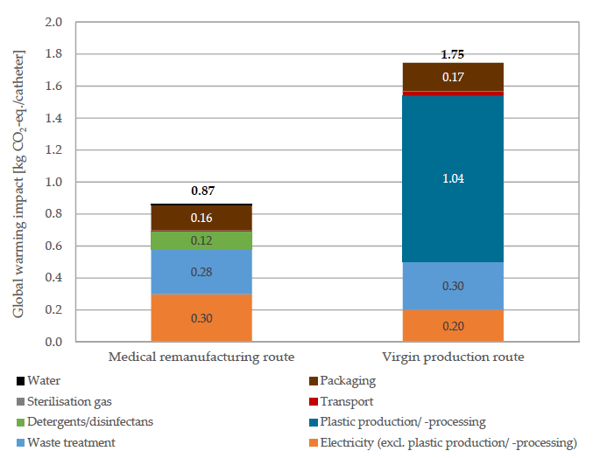Scientific Study Confirms: Cut the Environmental Impact in Half by Using a Reprocessed EP Catheter
The single-use paradigm in healthcare is under attack
The practice of throwing a device away after it has been used only once has come under attack during the pandemic: Hospitals have seen their supplies of critical devices depleted and regulators as well as practitioners have endeavored to find new was of re-using. Meanwhile, FDA regulated single-use device reprocessing is an established circular economy methodology for doing exactly this: Reusing devices to reduce environmental impact, reducing costs, and enhancing patient care. In many ways, hospitals should look to reprocessing as a template for how healthcare consumption practices can break with the single-use paradigm and realize this trifecta of benefits so eagerly sought for in healthcare.
We have always known that using reprocessed devices is lessens the environmental impact in the EP lab. However, a scientific study by Fraunhofer Institute for Environmental, Safety, and Energy Technology recently published in the journal Sustainability (it’s open source, so you can read it here) confirms it – and reports even better results than most of us expected: The environmental impact of using a reprocessed EP catheter is about 50% of the environmental impact of using a new one!
The environmental impact of using a reprocessed EP catheter is about 50% of the environmental impact of using a new one!
The study leveraged a so-called LCA (Life Cycle Assessment) analysis to arrive at this result, and since the LCA only looks at one instance of re-use, the scientists supplemented with Circular Economy metrics to accommodate the fact that some EP catheters can be re-used more than once. Many have questioned the overall environmental friendliness of reprocessing, since there is a lot of transportation involved (from the hospital to the reprocessing plant and again from the reprocessing plant to the hospital), a lot of chemicals involved, etc. However, the virtue of an LCA is that is takes into consideration every element in the life cycle, including the environmental impact of transportation, cleaning practices, etc.
The figure below (from the study) shows the difference between a reprocessed and a new EP catheter in terms of global warning impact.

The study leveraged a so-called LCA (Life Cycle Assessment) analysis to arrive at this result, and since the LCA only looks at one instance of re-use, the scientists supplemented with Circular Economy metrics to accommodate the fact that some EP catheters can be re-used more than once. Many have questioned the overall environmental friendliness of reprocessing, since there is a lot of transportation involved (from the hospital to the reprocessing plant and again from the reprocessing plant to the hospital), a lot of chemicals involved, etc. However, the virtue of an LCA is that is takes into consideration every element in the life cycle, including the environmental impact of transportation, cleaning practices, etc.
Clearly, the more times the device is re-used, the more compelling the difference in environmental impact.
This study should provide some tailwind for the many people inside (and outside) healthcare that work hard to reduce the environmental footprint of our healthcare system. Especially since reprocessing also provides important cost savings without increasing the safety risk for the patient. It’s simply hard to imagine many other environmental initiatives that immediately cuts the environmental impact in half.
It’s simply hard to imagine many other environmental initiatives that immediately cuts the environmental impact in half.



